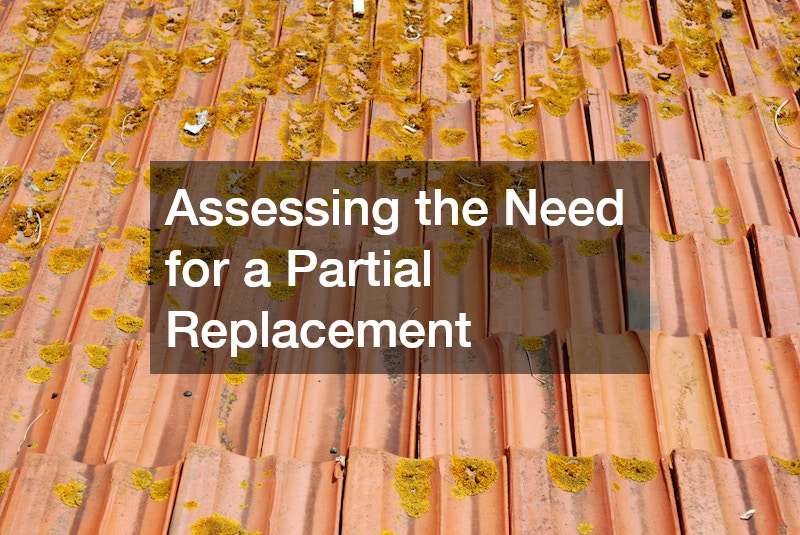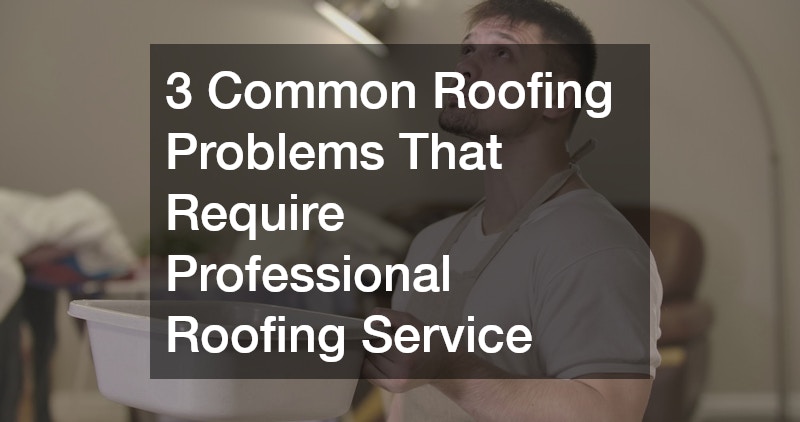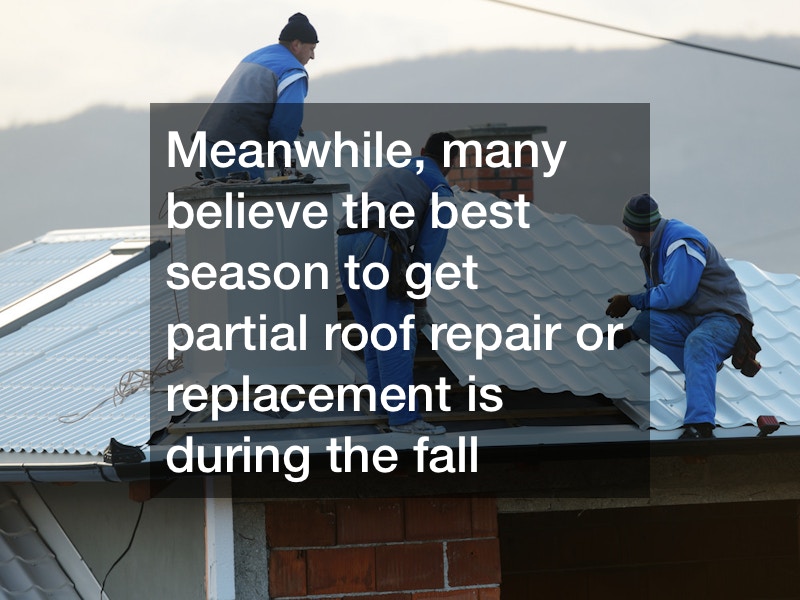When your roof starts showing signs of wear and tear, it may be time to consider a partial roof replacement. This comprehensive guide will walk you through everything you need to know about the process, from assessing the need for a replacement to finding a qualified contractor, and understanding the scope of work involved. By the end of this guide, you’ll be equipped with the knowledge to navigate the roof replacement process with confidence.
Assessing the Need for a Partial Replacement

Before jumping into a partial roof replacement, it’s important to assess the extent of the damage and determine if a full replacement is necessary. A reputable roofing company can help you evaluate the condition of your roof and recommend the best course of action. In some cases, a roof replacement may be sufficient to address specific issues while prolonging the life of your roof.
Factors such as age, the extent of damage, and the overall condition of your roof will influence the decision to opt for a partial replacement. Working with a professional roofing contractor can help you make an informed decision that aligns with your budget and long-term goals for your property.
By choosing a roof replacement, you can address localized issues without the need for a complete overhaul. This targeted approach can save you time and money while ensuring that your home remains protected from the elements.
Finding a Qualified Contractor
When it comes to roof installation, finding a qualified contractor is key to a successful project. Look for a roofing company with a solid reputation for quality work and customer satisfaction. A reputable contractor will have the expertise and experience to handle a partial roof replacement with precision and attention to detail.
Before hiring a contractor, take the time to research local roofing companies and read reviews from past customers. Ask for references and view examples of their previous work to ensure they have the skills necessary for your project. By choosing a reputable roofing service, you can have peace of mind knowing that your roof replacement is in good hands.
A siding contractor may also be able to assist with your roof replacement, especially if the damage extends to the exterior walls of your home. Collaborating with professionals who understand the interconnectedness of different home components can help streamline the replacement process.
Initial Inspection and Estimate
Once you’ve selected a roofing contractor for your partial roof replacement, the next step is to schedule an initial inspection and estimate. During this phase, a roofing professional will assess the condition of your roof and provide a detailed breakdown of the work required. This estimate will outline the scope of the project, materials needed, and the timeline for completion.
Be sure to communicate your expectations and budget constraints to the roofing contractor during the initial consultation. This will help ensure that the estimate aligns with your needs and allows for a smooth and efficient roof replacement process. Transparency and clear communication are essential for a successful project outcome.
By working closely with your roofing contractor to finalize the estimate, you can set realistic expectations for the replacement project and avoid any surprises along the way. A detailed estimate will serve as a roadmap for the work ahead and help you track progress at each stage of the roof replacement.
Understanding the Scope of Work

Before the partial roof replacement commences, it’s important to have a thorough understanding of the scope of work involved. Your residential roofing contractor should provide a detailed plan outlining the specific repairs or replacements needed, as well as the anticipated timeline for completion. This information will help you prepare your home and yard for the upcoming project.
Be sure to ask your roofing contractor any questions you may have about the scope of work, materials being used, and the overall process for the roof replacement. Understanding what to expect at each stage of the project will ensure that you are fully informed and can make informed decisions throughout the replacement process.
By having a clear understanding of the scope of work, you can collaborate effectively with your roofing contractor and ensure that the roof replacement is completed to your satisfaction. Open communication and a transparent approach are key to a successful roofing project.
Preparing Your Home and Yard
Prior to the start of the roof replacement, take the time to prepare your home and yard for the upcoming construction work. Clearing the area around your home of any obstacles or debris will make it easier for the roofing service to access your roof and perform the necessary repairs. Additionally, protect any landscaping or outdoor furniture that may be impacted by the replacement process.
Inform your neighbors about the upcoming partial roof replacement, as the construction work may generate noise and temporary disruptions. By communicating with those around you, you can minimize any inconvenience and ensure a smooth replacement process for everyone involved. Working proactively to prepare your home and yard will set the stage for a successful project outcome.
By taking these steps to prepare your home and yard, you can create a safe and efficient work environment for the roofing contractor and their team. Investing time in preparation will help streamline the replacement process and minimize any potential delays or interruptions.
The Replacement Process: What Happens First
Once all preparations are in place, the partial roof replacement process can begin. The first step typically involves the removal of damaged or deteriorated roofing materials, such as shingles or tiles. This initial phase sets the stage for the installation of new materials and ensures a clean and stable foundation for the replacement project.
During the removal process, your roofing contractor will inspect the underlying structure of your roof for any signs of damage or deterioration. Addressing any hidden issues early on can prevent future complications and prolong the lifespan of your roof. By working with a qualified local roofing company, you can trust that these critical inspections are conducted with care and attention to detail.
Following the removal of old materials and the inspection of the roof structure, the installation of new materials can begin. Your roofing contractor will carefully lay down new shingles, tiles, or other roofing materials according to the agreed-upon plan. This phase of the replacement process requires precision and expertise to ensure a durable and watertight roof for years to come.
Addressing Hidden Issues

Throughout the roof replacement process, it’s not uncommon for hidden issues to surface as old materials are removed and the roof structure is exposed. Your local roofers should address these issues promptly to prevent further damage and ensure a successful replacement project. By working with experienced professionals, you can trust that hidden issues will be identified and resolved with care.
Common hidden issues that may arise during a roof replacement include water damage, rot, or inadequate insulation. It’s essential to address these issues proactively to prevent them from worsening and compromising the integrity of your roof. With the expertise of your roofing contractor, you can rest assured that hidden issues will be addressed effectively and efficiently.
By having open communication with your roofing contractor and trusting their expertise, you can navigate hidden issues during the replacement process with confidence. Proactive problem-solving and a collaborative approach will ensure that your roof remains in top condition for years to come.
Installation of New Materials
Once any hidden issues have been addressed, the installation of new roofing materials can proceed. Working with a reputable local roofing company ensures that high-quality materials are used for your partial roof replacement. Whether you opt for traditional shingles, metal roofing, or another type of roofing material, your contractor will expertly install them according to manufacturer guidelines.
During the installation process, your residential roofing contractors will pay close attention to detail and ensure that all materials are properly secured and sealed. This meticulous approach guarantees a watertight and durable roof that withstands the elements for years to come. By investing in top-quality materials and skilled installation, you can enjoy peace of mind knowing that your roof is in good hands.
Following the installation of new materials, your roofing contractor will conduct a thorough inspection to confirm that the replacement work meets industry standards and your expectations. This final quality check ensures that your roof is ready to protect your home and withstand the test of time.
Ensuring Proper Ventilation and Insulation
As part of the partial roof replacement process, it’s crucial to ensure proper ventilation and insulation for your roof. Adequate ventilation helps prevent moisture buildup and heat retention in your attic, improving energy efficiency and prolonging the life of your roof. Your roofing contractor will assess your current ventilation system and make any necessary adjustments to ensure optimal airflow.
In addition to ventilation, proper insulation is essential for maintaining a comfortable and energy-efficient home. Your residential roofing contractors can recommend insulation solutions that meet local building codes and enhance the performance of your roof. By investing in proper ventilation and insulation, you can create a healthier and more comfortable living environment for you and your family.
By working with experienced professionals to address ventilation and insulation during your roof replacement, you can maximize the longevity and performance of your roof. Proactive measures to improve airflow and insulation will help safeguard your home against temperature fluctuations and minimize energy costs over time.
Clean-Up and Final Inspection
Once the partial roof replacement is complete, your roofing contractor will conduct a thorough clean-up of the work area to ensure that any debris or materials are removed. This final step is essential for restoring the appearance of your home and yard and ensuring that no hazards remain after the replacement process. A reputable gutter repairs service may also be able to assist with cleaning and maintaining your gutters.
Following the clean-up, your contractor will perform a final inspection of the replacement work to confirm that all tasks have been completed to your satisfaction. This quality check allows you to review the work done and address any concerns before finalizing the project. By prioritizing cleanliness and attention to detail, your roofing contractor demonstrates their commitment to excellence.
Before concluding the replacement project, your roofing contractor will provide you with warranty information and maintenance tips to help you care for your new roof. By following their guidance and regular maintenance practices, you can extend the lifespan of your roof and preserve its performance for years to come.
Warranty and Maintenance Tips

Upon completion of your roof replacement, your contractor should provide you with a warranty for the work performed. This warranty serves as a guarantee of quality and ensures that any issues arising from the replacement work are addressed promptly. Be sure to review the terms of the warranty with your roofing contractor and ask any questions you may have.
In addition to the warranty, your roofing contractor may offer maintenance tips to help you care for your new roof and prevent future damage. Following their recommendations for routine inspections, cleaning, and minor repairs can help extend the lifespan of your roof and maintain its appearance. By investing time in regular maintenance, you can avoid costly repairs and preserve the value of your home.
Additionally, it’s essential to keep detailed records of all maintenance activities and repairs related to your roof. Documenting these actions not only helps you stay organized but also provides valuable information should you need to make a claim on your warranty or sell your home in the future. Maintaining a log of inspections, cleaning schedules, and any repairs will demonstrate to potential buyers that you’ve taken proactive steps to care for your roof, potentially increasing your home’s value and appeal. This diligence can ultimately lead to greater peace of mind as you protect one of your most significant investments.
Embarking on a partial roof replacement may seem daunting, but with the right knowledge and support, you can navigate the process successfully. By assessing the need for a replacement, finding a qualified contractor, and understanding the scope of work involved, you can set the stage for a seamless project. From the initial inspection to the installation of new materials, each step of the replacement process plays a crucial role in ensuring the longevity and performance of your roof. By prioritizing proper ventilation, insulation, and maintenance, you can enjoy a durable and energy-efficient roof that enhances the comfort and value of your home.



